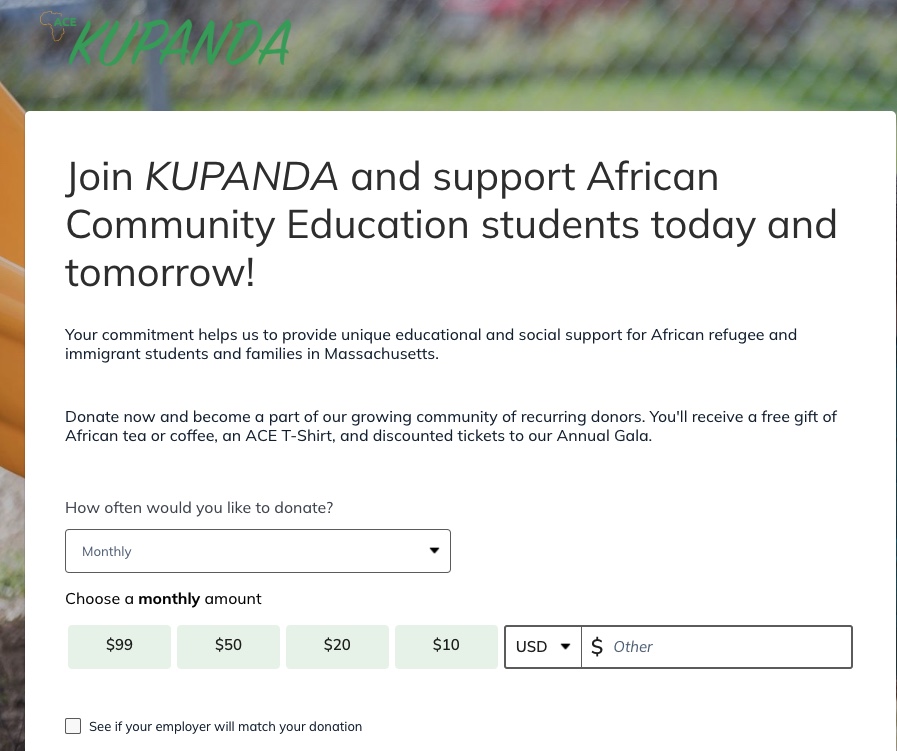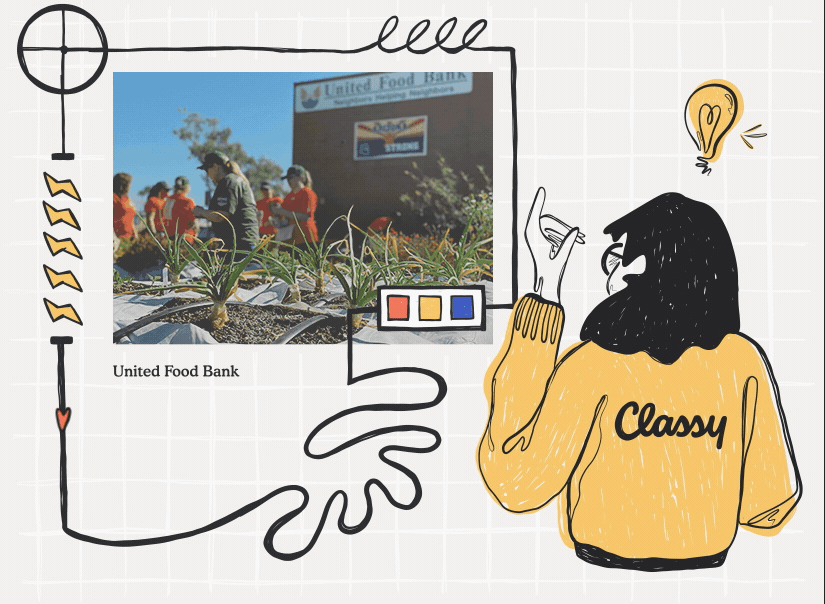How to Get Donations for Your Nonprofit: 8 Simple Tips

A lasting impact starts with knowing how to get donations year-round. You might be looking for new fundraising approaches to generate revenue for your nonprofit, or you might be curious about how to start a nonprofit and gather donations for the first time. Either way, you’ll find valuable takeaways as you read on.
You’re about to explore eight simple tips for getting donations for your nonprofit. These tips come from trends across more than 12 million donations completed on the Classy fundraising platform, as well as donor sentiment insights from our ongoing third-party research.
Consider this a simple roadmap to hook new and existing donors. We’ll cover everything from how to greet donors with a smooth donation site, to how you can encourage expanded giving through recurring donations and peer-to-peer fundraising. Let’s get started.
Tip #1: Know Your Target Audience
The first step to getting donations is to understand who your donors are. This is your opportunity to get creative about which donor segments you’re looking to target.
As you build your donation site and first donation requests, details about the audience you’re trying to resonate with will be critical. This information can become your solid foundation on which to base all other decisions.
Take time to define your ideal donors
You may already know which supporters are most interested in your cause category. If not, we’ve got you covered. Take the time to understand what defines your donor base to speak directly to them as you ask for donations.
This is especially important if you’re looking to pivot the groups you’ll target in the future. You could also take it a layer deeper by identifying individuals who have demonstrated a particular passion for your organization. We’ve built a few questions to start your exploration below.
Ask yourself:
- What is the age group or generation(s) your target audience falls in?
- Which social media platforms or sources will you use to reach your target donors?
- Will you find more support locally or by targeting a nationwide audience?
- What other interests will your ideal donors hold?
- What communities would your ideal donors be members of?
Download our Campaign Field Guide Series for interactive worksheets to further define your donors and how to reach them, as well as how to design an effective campaign and execute communications.
Learn what motivates different donor groups
Our annual Why America Gives report shows that the economy, current events, and challenges like the COVID-19 pandemic continue to impact giving. Once you know whom you’re targeting, you can use these insights to understand how various groups stay motivated to donate.
Start with our annual donor sentiment research. You can see a snapshot of our recent generational giving breakdown to discover which donors are most likely to give to your cause category and what keeps them engaged.
Tip #2: Choose the Right Technology
Before you invite donors to contribute to your cause, ensure you’re offering a seamless giving experience. Your donation site is the page your excited supporters will land on to donate. It’s the moment they decide to complete a donation or abandon the page, making it critical to think through this checkout process proactively.
Choosing the right tool to build your donation site
Your nonprofit has choices when it comes to the donation experience you’re looking to offer. Many nonprofits establish a donation website dedicated solely to collecting funds. You could also add a donation button to your existing website that links visitors to a simple donation form.
Think about how to meet donors’ expectations with the technology they want to use. That way, you’re in the best position to secure their generosity after attracting them to your pages. Choose the best fundraising technology for your organization’s current state while thinking about what may benefit you as you grow.
Tip #3: Make It Easy to Give Through Your Donation Site
The list of donation site best practices available to help you is extensive. Here are a few key points to prioritize based on our latest research.
Donation Site Best Practices
1. Make your main donation button shine above all else
The first step to getting someone to your donation form is optimizing your donation button.
The top factor donors say leads to an excellent experience is that a nonprofit clearly explains the impact a donation will have on their cause. That’s where your donation button placement, language, and supporting context will make a big difference.
You’ll want to customize your donation button using the information you have about your target donors and what appeals to them. For example, placing a “Donate Now” button on your website is fine, but could be more personalized.
Imagine having that button sit below a text blurb that reads, “For as little as $10, you can rewrite the future of American students facing hunger.” Page visitors now understand exactly what your nonprofit can accomplish with their generosity. That goes a long way in building their trust and motivating them to come back again.
2. Reduce friction for your donors in the process
One of the top reasons a donor reconsiders donating is they do not see the payment option they prefer. The payment step seals the deal, so get ahead of any friction there.
Think beyond credit cards to payment types offered by modern consumer brands. Including PayPal, Venmo, and even cryptocurrency on your donation page is a great way to provide donors with the flexibility they expect. When donors see an option that feels trusted, secure, and simple, they’re more likely to follow through.
3. Make sure the mobile experience feels natural
We saw that 56% of donor traffic to a donation page in 2021 came from a mobile device. First and foremost, make sure your website is mobile-friendly. Aim to include as few form fields on the donation form as possible and short instructional text that informs the donor without crowding their screen.
The only way to know how the experience feels on mobile is to test the look and feel of your donation page on a few different devices and browsers. Adding mobile-friendly payment options will boost the experience too.
Tip #4: Personalize Your Asks for Donations
Now you’re ready to request donations from your target audience. Let’s go over a few ways to make your donation appeal stand out and which channels might be best suited for your request.
Stand out from other donation requests
Think about the person on the other end of your appeal and what will make them feel special. Your first ask for a gift is your opportunity to build a relationship with that prospective supporter. Leaning on a voice and tone that feels human is a strong start.
One rule of thumb is to always greet your potential donors by name. Offer details about what their contribution means to you personally, as well as what it will accomplish for your organization.
You’ll also want to note what’s happening in your supporter’s world. Suppose an economic downturn or other current events have made a noticeable impact on your community. Recognizing this can add a sense of urgency to your ask.
Take every chance to share images or videos to make your story come to life. Present visuals that help donors see themselves as part of the solution to the timely challenge you’re tackling. And lastly, always leave more ways to connect with your organization (social links, website, email) in each of your communications.
Tip #5: Choose the Right Marketing Channels
When you know whom you’re talking to, where you’re sending them, and how you’ll frame your ask for donations, it’s time to think about where to share that ask. Take a look at a few channels you can use to bring donor traffic to your donation pages and alert supporters about new opportunities to give.
Marketing Channels for Your Donation Site
Direct mail
Send a physical letter or postcard to your target donor audience to add that personal touch. Get creative about promoting your online donation page on paper with tools like a QR code generator that links back to your site.
Email outreach
Email, compared to other marketing channels, drives the second-highest percentage of traffic to fundraising campaigns (27%) that go on to complete a donation. A thoughtful email strategy is powerful for reaching donors. Think about how you can elevate the correct information with an engaging flair to drive people to take action.
Social media
Social media is an increasingly important strategy for donor acquisition. Each platform has its benefits in reaching different audiences.
We see that overall, Facebook drives the most traffic to campaigns. We also see that LinkedIn is the most likely to convert that traffic to a completed donation. Play around with a strategy that works for you, based on your target audience and goals.
Fundraising events
Both in-person and online events are a great way to reach potential donors. Get creative with an event idea that gives you an outlet to engage new and existing supporters. Welcome them in and offer meaningful ways to connect. From there, share ways they can take action during your event and have a solid plan to nurture those relationships after the event ends.
We recently talked to African Community Education (ACE) about how they use an annual gala to rally supporters around their mission. Their investment in the events space as an outlet for relationship-building and donations helped triple their gala revenue between 2019 and 2021.
Read the Full StoryTip #6: Encourage Repeat Donations
Right now, your focus may be on securing your first donations, but it’s important to think ahead to maximize the lifetime value of your new donors. Imagine your one-time $25 gift could be a monthly $25 contribution that adds up over time. That type of financial power and predictability comes from tapping into recurring donations.
Explore recurring donations
Recurring donations can help you better predict your income. Turn one-off donation requests throughout the year into reminders of why being a regular donor is so valuable.
The key to attracting recurring donors is a strong value proposition. Highlight the benefits of being a member of your recurring donor community and the value it’s providing your organization financially. Make donors feel special for contributing so significantly to your cause, and regularly update what that means for the work you’re doing or those you’re helping.
Make recurring giving an option for any donor
Many fundraising solutions will offer recurring giving as an option to add to your donation page. That offering allows you to add a recurring donation option to your donation site and checkout form to make sure every donor is aware of the opportunity to expand their impact.
The more you elevate the option, the more donors will opt in and spread their generosity in the best way for them. Our Recurring Donor Sentiment Report shares why donors enjoy recurring gift options:
- 56% feel their recurring gift enables them to support the organization continuously
- 47% feel like their ongoing donation is making more of an impact than a one-time gift
- 38% feel more connected to a nonprofit when they give regularly
Your recurring donation option can also present donors the chance to give at the frequency (monthly, weekly, daily, etc.) and gift size they prefer.
Adding the recurring giving frequencies outside of monthly giving will help us grow our program and achieve our goals. Our eyes have opened up about the importance of recurring giving.

Tip #7: Tap Into Your Donors’ Networks to Increase Giving
Peer-to-peer fundraising is a big topic within our annual report, The State of Modern Philanthropy. We’ve seen just how impactful it can be to fundraise within a community, especially in times of economic fluctuations.
Explore peer-to-peer fundraising
Look at each donor who supports your cause as a member of a larger community. By doing so, you open the door to greater levels of support when they advocate for your cause and engage their personal networks on your behalf.
Peer-to-peer fundraising gives existing donors a simple way to solicit their networks for donations to support your cause. Modern tools will make it easy for your donors to spin up a branded individual fundraising page. That page can then be shared with their colleagues, family, friends, social media networks, and communities.
Understand the Psychology of Peer-to-Peer
Take advantage of the strong ROI of peer-to-peer fundraising
The average individual’s fundraising page on Classy experienced a 34% year-over-year increase in donations between 2020 and 2021. It’s also important to note that a single individual fundraising page on Classy brings in an average of 20 donors.
Suppose you got only five donors to participate in peer-to-peer fundraising. Even that could help you potentially reach 100 donors as a result.
We have grown our peer-to-peer efforts considerably. Not only have we seen fundraising totals increase, but we’ve seen donors deepen their relationships with our organization.
Tip #8: Regularly Evaluate What’s Working and What’s Not
At first, you may start out trying a lot of different ways to get donations for your nonprofit. It’s normal to navigate decisions without real insight at the beginning stages of your development since there’s no concrete evidence to tell you what’s working.
As you build your strategy over time, you’ll have some important and valuable metrics at your disposal. Lean on those for guidance when you decide what you’ll continue and what might not be resonating.
Track the right metrics early on
We’ll leave you with a list of a few metrics to track as you begin receiving donations to help you improve for the future.
- Average monthly overall donation volume
- Average monthly overall donor count
- Breakdown of recurring vs. one-time gifts
- Average one-time donation amount
- Average recurring donation amount
- Average recurring donation frequency
- Top sources of donor traffic to your donation page
- Average conversion rate of site visitors to completed donations
Collect data to build relationships that bring donors back
The data you’ll gather about your donors is just as important as transaction-based metrics. Collect the right data about your donors during the process to personalize the experience for future outreach and build a more authentic relationship.
Get Ready to Secure Donations for Your Nonprofit
If you need help getting started, the Classy team is here for support. Subscribe to our blog to get more resources and best practices sent to your inbox weekly.

Drive More ROI From Your Campaign Portfolio



